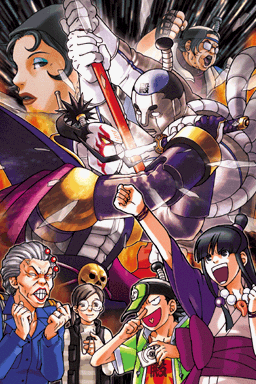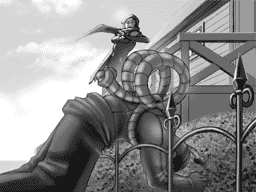Phoenix Wright: Ace Attorney – System and Limitations
June 10th, 2011
With E3 wrapping up and my holiday over I can slip back into my regular writing schedule. Without further ado…
Game Introduction
http://www.youtube.com/watch?v=detQxA_5BdUPhoenix Wright: Justice for all
Phoenix Wright is a series of puzzle games presented in the form court room dramas staring the titular lawyer as he defends clients in a series of murder cases. Alongside similarly unconventional games like Trauma Centre, Scribblenauts and Professor Layton, Phoenix Wright has come to define the types of alternative game experiences that can be had with the DS hardware.
Unfortunately the series has had a bizarre release schedule in Australia. The first game, Ace Attorney, was released in 2009, 2 years after the second game, Justice for All, made it out here. The 3rd game Trials and Tribulations wasn’t released in Australia, but a PAL version was made for Europe. The later spin-offs Apollo Justice and Miles Edgeworth games were released here within days of their European and American counterparts. Just last year the 3 games in the Phoenix Wright line of the series were ported to WiiWare in Australia. Each game is shipped in very limited numbers. Rarely have I seen any of the games on store shelves. Ironically enough, I’ve actually been playing the recent iOS port of the original game which, confusing release schedules aside, seems to be a good introduction to the series.
Gameplay Overview
Each Phoenix Wright game is organised into 4-5 cases with their own story arcs. Cases begin with a short cinematic that gives a glimpse of the event taking place, usually revealing the perpetrator of the crime. From then Phoenix is drawn into the story and the investigation phase begins. In the investigation phase, the player can go examine the crime scene, pick up clues and talk to people of interest. In this time the player will amount physical evidence as well as pieces of information which are highlighted orange in the text. Physical evidence is stored under the court records, an inventory screen that the player can utilise for further investigation and during court. Pieces of information though aren’t stored anywhere in-game, instead the player must remember and then recall the facts later when needed in court, stressing knowledge skills.
Only once enough evidence is gathered, the court room trial will begin. In the trial the player/Phoenix plays the defence, the prosecution calls people to the stand to give testimonies. Here, the player needs to look for contradictions in the testimonies, object and then present the physical evidence which shows the contradiction. Since breaking the witnesses testimonies uncovers new developments, the investigation and trial phases are usually reopened another 2 times so that the lawyers can further investigate. In each of these instances there are new leads to follow which open up new information and further clarify the events of the murder.
The Roles of Investigation and the Court
The investigation phase is all about building the narrative of events through evidence. It’s actually impossible to fail here as the game won’t progress until the player has found all the clues they need. This is so not as to unfairly disadvantage the player when they’re looking for contradictions in court. As such, the investigation parts of the game lacks the later tension of the court room.
In the courtroom, if the player presents the wrong evidence in objection to a testimony, they will be penalised 1 of 5 free opportunities to make a mistake. With the possibility of failure on the line, breaking testimonies is where Phoenix Wright requires the player to apply the evidence and information from the investigation phase and use their knowledge skills. Because a fail state is present (the only part of the game where this is so), objecting to testimonies is where the core gameplay lies, and thus where we’re going to begin our analysis.
Understanding the Process of Objecting
When the player is picking up clues in the investigation phase, they use these clues to build a narrative in their head. When reading the testimonies in court, the player must actively compare the narrative presented by the witness to the their own narrative based on the proof they’ve gathered. The challenge comes from memorising all the evidence and being able to adapt that knowledge to the situations thrown up in court.
The testimonies are presented in 5 or so sets of grouped sentences that the player can cycle through without the pressure of a time limit. This way the process of identifying contradictions is simplified as the player can only find the contradiction in one of a few defined places.
Sometimes details in the testimonies are vague, so the player can press the witness for clarification. Pressing witnesses doubles the amount of possible information in a testimony, but that extra layer of information can be optionally accessed. This optional layer of depth gives the player more to work which can make finding contradictions easier, but also harder if the witness is unwilling to talk and only presents vague information (making it harder for the player to find where the contradiction lies). Pressing turns finding contradictions into a 2 step process and gives the designers the option to leverage this process to clarify or further muddle a testimony.
Types of Contradictions
Contradictions tend to work on a sliding scale between these two points:
Mistakes
This is when the witness’ account plainly contradicts the evidence. For example, in Day 3 of Episode 2, Witness’s Account, Redd White states that “The victim ran to the left, and you gave chase!” which contradicts May’s testimony that the victim ran to the right. White’s later statement that the victim died from a single blow is also an example of a mistake.
Hypothesis
Sometimes the objections are hypotheses formulated on the evidence (physical and information). For example: in Day 4 of Episode 3, The Day of the Murder, Vasquez claims that she wouldn’t be able to lift the Samurai Spear to kill the victim. Furthermore, the spear itself was broken. So, the player is asked by the judge to suggest how exactly she could have killed the victim. In response the player can present a 5-year old photo which shows another person being impaled on the spikes and the Vasquez looking on in shock. Phoenix then suggests that the same event occurred a second time. At the end of Day 3 of the 4th case, multiple choice questions are thrown at the player where they need to hazard a hypothetical situation based on the information already known.
The Chasm between Process and Mechanics
Now that we understand the process that the player uses to find contradictions and the tools in-game that allow the player to present them to the court, we can explore where exactly the game fails to meet the player.
Presenting Narratives through inventory
For the most part the player will prove their contradictions by presenting an item from the court records to the court. The contradictions are pieces of the narrative that the player has constructed out of the total evidence they’ve gathered. The problem is that a single item of evidence is an inadequate representation for this narrative built on evidence.
The consequences of this disparity between player process and mechanics are two-fold. Maybe you present the correct item, but Phoenix proposes a different theory. In this way it feels like the game is putting words in your mouth. Let’s take a theoretical example. A man is killed while scaling a mountain with his friend, the accused. The evidence is a pair of scissors. Maybe I think that the murderer used scissors to cut the rope which sent the victim falling to his death, so I present the scissors and my choice is correct, but actually Phoenix instead says the victim was stabbed to death on the mountain.
Sometimes it’s the other way around. The player’s narrative is correct, but they present an item that, while involved somehow in the narrative, isn’t what the game wants you to present. For example, on Day 3 of Episode 3 in response to Cody’s Witness Account testimony I presented Cody’s Path to Glory photo album to prove that he it was uncharacteristic of him that he wouldn’t bring his camera with him as often takes photos of the Steel Samurai and puts them in his album. Actually, the game wanted me to present the camera itself because he didn’t have the camera. Sometimes you have the right answer, but you’re not sure which piece of evidence to present.
Potential Contradictions aren’t accepted
Again, this point pertains to what the game is willing to accept and not accept, the game’s logic, so to speak. Because the evidence builds a narrative and within that narrative there is flexibility for the player to construe their own theoretical situations, there are occasions where a perfectly logical contradiction within the framework of evidence can’t be accepted by the game.
This sort of complaint seems to be commonly held against the series. That Phoenix Wright only allows you to follow it’s logic and not your own. Actually, there’s very little that can be done about this from a design standpoint. The only way to fix this issue would be the make the presentation of all evidence prove an acceptable contradiction and even then, there’s good odds that the justification layed down by Phoenix won’t match with the player. In a game where the player is asked to draw pieces together trough pieces of information and inanimate objects, this type of problem arises, you can’t support all possibilities. All that can be done is to choose the right pieces of physical evidence and information evidence to lead the player down the right path, while leaning the gameplay closer towards mistake contradictions and further away from letting the player inventing their own hypotheses.





 Game Design Companion: A Critical Analysis of Wario Land 4 - $7.99
Game Design Companion: A Critical Analysis of Wario Land 4 - $7.99 Level Design: Processes and Experiences
Level Design: Processes and Experiences Speed Boost: The Hidden Secrets Behind Arcade Racing Design - $5.99
Speed Boost: The Hidden Secrets Behind Arcade Racing Design - $5.99 Adventures in Games Analysis: Volume I - $5.99
Adventures in Games Analysis: Volume I - $5.99







